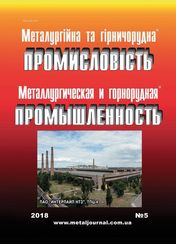Analysis of electron-optical studies of experimental alloys of Fe-W and ferrotungsten |
\\ Статьи
Analysis of electron-optical studies of experimental alloys of Fe-W and ferrotungsten
In this paper the experimental alloys of the Fe-W, which melted with refractory W - Ni - Fe scrap, compared with the standardized grade ferrotungsten ФВ 70. The comparative analysis of the microstructure, phase and chemical composition of the experimental alloys. Investigated the number of non-metallic impurities, the number of which is within the nominated GOST 17293-93. It is proposed to re-use as a substitute for ferrotungsten alloys for the manufacture high tungsten special materials based on iron.
Keywords: electron-optical analysis, structural-phase composition, the alloys of the Fe-W non-metallic impurities, ferrotungsten.
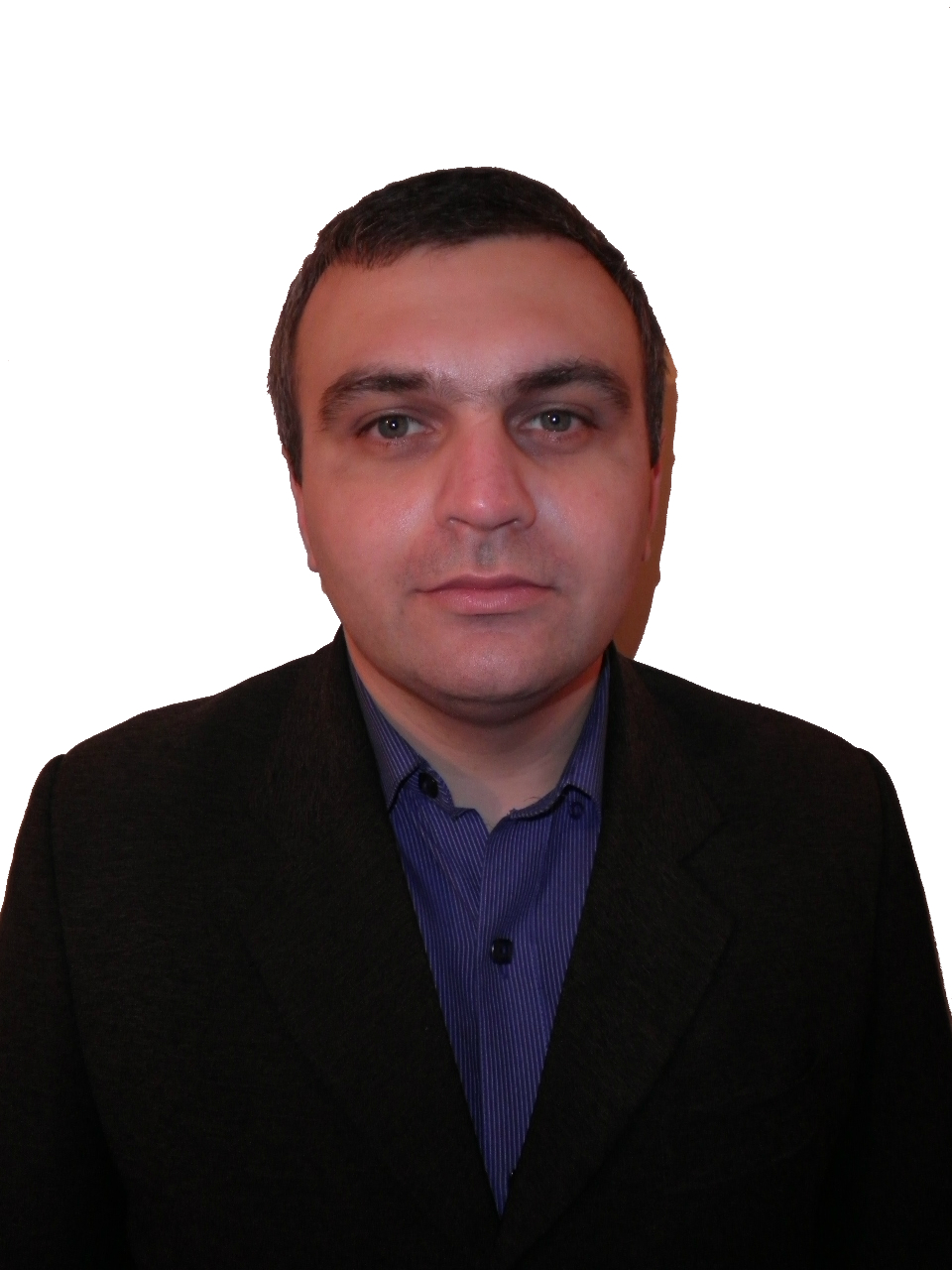
Alexandr Glotka
Doctor of Science, docent of material physics department,
Zaporizhzhya Natuional Technichal University
Phone: +380617698282; +380617698284
E-mail: [email protected]
While using high-melting temperature alloying elements, when they are pure, their solution in the liquid alloy requires a lot of energy input. With the purpose of cost cutting the ferroalloys are used. They dissolve quickly in steel bath as they contain ferrous elements. The time of solution shortens while the iron content increases [1].
Ferrotungsten is smelted with the usage of tungsten-containing ores with addition of iron cutting wastes or scale. For the reduction reaction oil or coke pitch, granulated ferrosilicon or powdered aluminum are added [2]. In accordance with GOST 17293-82 the quantity of tungsten in alloys hovers around 65-80%.
Recently the price for alloying elements jumped essentially, that is why the usage of highly alloyed steel, to which tailored materials are related, which are used in gas and power engineering are limited greatly. Metal products market shows that the value of ferrotungsten varies within 220 - 230 hr/kg [3, 4]. At the same time the prices for refractory scrap containing tungsten is 55-80 hr/kg [5]. In such a way, the usage of scrap containing certain amount of alloying elements for smelting of alloys of Fe-W will reduce essentially the prime cost of highly tungsten tailored materials and other tungsten containing alloys [6].
The aim of this work is to provide the comparative analysis of electron-optical researches of Fe-W alloys and ferrotungsten for determination the opportunity of experimental alloy further usage while manufacturing tailored materials used in gas and turbine manufacturing.
Research methodology
For the alloy of Fe-W type producing the refractory scrap of W-Ni-Fe was used, containing about 80% of tungsten [7] and commercially pure iron. Alloy rendering was performed in OKB 862 furnace in air in the graphite crucible, heating was executed till full liquefaction of the components. Six ingots mass 200g were liquated with concentration of tungsten 30, 50, 70% (by two melting operations thereafter).
The alloys phase composition analysis is executed on DRON-1 diffractometer in copper radiation with monochromatization of diffractive beams. The phases nature was determined by comparing experimental value of interplanar distances ![]() with tabulated data [8]. The margin of error did not exceed 1.36 × 10-4nm.
with tabulated data [8]. The margin of error did not exceed 1.36 × 10-4nm.
Chemical composition and microstructure of samples were studied with the help of JSM 6360 electron-scan microscope (produced by JEOL, Japanese) and 106I electron-scan microscope (produced by SELMI, Ukraine), which are fitted with X-ray spectral energy-dispersive microanalysis (EDX) under accelerative stress 20 kV and sonde current strength 4 nA in secondary electrons. The quantity of each element was determined by comparison of sample radiation rate with the intensity of basic standard element which are supplied with software. The study was carried out using mechanically polished samples with the following chemical milling (using agent “Marbl” within 5-10 seconds).
Results of analysis and its discussion
While smelting of alloys of Fe-W a change in ingot mass compared with charging mass was fixed. The difference fluctuated within 1% (for the alloy with 30% of W) and 6.7% (for the alloy with 70% of W).
Samples for microstructure analysis were cut out parallel to vertical axis of the ingot in order to analyze tungsten allocation.
Analysis of alloys microstructure showed that alloy of Fe-30% W has heterogeneous structure with great amount of impurities of secondary phase, which has heterogeneous morphology (from needlelike to spherical inclusions) (fig.1). Such structure nonuniformity is explained by nonequilibrium of ingot crystallization.
X-ray structure analysis showed that the structure consists of iron-based a-solid solution and intermetallic compound Fe2W ( l- phase). Intermetallide is formed by peritectoid reaction at the temperature 1060 C with a (Fe) and m- phase (Fe7W6) [9]. Fe2W disappears at continuous quenching (2000 hours) at the temperature 1000C and has the lattice constant а = 0,4737 nm b = 0,7700 nm.
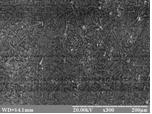
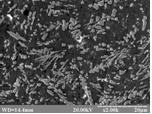
а b
Fig. 1 Alloy microstructure of Fe-30% W system (а-×300; b-×2000)
With the help of EDX analysis the difference in chemical composition of basic metal and impurities was determined. The average value of chemical composition for base metal is within 67,14 % Fe - 1,45 % Ni -31 , 41 % W; while the impurities have the following composition : 25,58 % Fe - 0,63 % Ni -73 , 79 % W.
According to this data, the impurities chemically will approach to the intermetallide stoichiometry of Fe2W type.
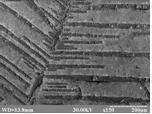
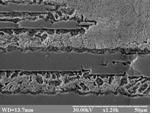
а b
Figure 2 Alloy microstructure Fe-50% W (а-×150; b-×1200)
Alloy microstructure of Fe-50% W of scrap is given in figure 2 at different magnifications. The structure is rather developed with dendritic branches of different degree, between which there are areas with eutectic structure. Eutecticum has a platelike shape associated with “basketwork”.
The alloy phase composition analysis showed that the structure consists of iron-based a-solid solution and intermetallide Fe7W6. This compound ( m - phase) is formed in the system under peritectic reaction from the melting containing 20.6% (atomic mass) of tungsten [9]. According to the data [10], intermetallide is stable in large temperature ranges from 1637 C to ambient temperature and disappears only at soaking 1000C during 2000 hours. m- phase has the homogeneity limit from 39% to 45% W [11]. Depending on the chemical composition lattice constant also changes: а = 0,4755 nm b = 2,583 nm – for alloys rich in iron, а = 0,4771 nm , b = 2,596 nm – for alloys rich in tungsten.
The groundmass has such chemical composition: 59,34 % Fe - 7,85 % Ni -32 , 81 % W, while platelike inclusion - 41,24 % Fe - 4,91 % Ni -53 , 85 % W. According to chemical composition, the platelike phase does not correspond to intermetallide stoichiometry Fe7W6, but the experimental alloy should be considered as the one, containing not two but at least three elements (W - Fe - Ni ). This can lead to dislocation of concentrated interval of m-phase existence in the limits less than tungsten concentration. Besides, in the work [12] one may see that phase can correspond to the formula Fe3W2, i.e. it can change the relation between elements content, depending on conditions of crystallization and amount of tungsten.
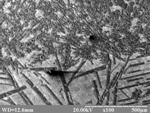
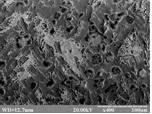
а b
Figure 3 Microstructure of Fe-70%W alloy (а- ×100; b - ×400)
Fe-70% W alloy has the similar ingot microstructure with Fe-50% W alloy. Together with dendritic inclusions of needlelike type, it can be seen eutectic component of platelike type (fig.3). However, in certain areas of ingot there are spherical inclusions, which were not observed in any of the materials mentioned above (fig. 3, a)
Phase-shift analysis showed that apart from a-phases (Fe) and Fe7W6 that are present in alloy of Fe-50%W, there appears tungsten-based a-solid solution. The analysis of elements allocating over the metallographic sample surface showed the presence of tungsten in lamellar precipitate with the reducing amount of it from the center to the edge. Rounded particles are the solid solution, tungsten-based with its amount at the rate of 90-95 %. Probably, tungsten particles, which entered the alloy with refractory scrap and have not dissolved in melting, become origination centers of m-phase. Undersupply of iron for intermetallide formation is also possible.
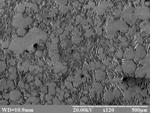
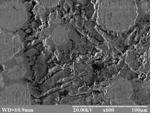
а b
Figure 4 Ferrotungsten microstructure FeW 70 (а-×120; b - ×600)
The comparison of alloy microstructure of Fe-70%W and general ferroalloy FeW 70 (fig. 4) let us know there are greater amount of spherical inclusions in ferrotungsten, which are classified as tungsten-based solid solution and the amount of laminose phase is far less. Such difference leads to the increase of heat amount and dissolution continuance of alloy compared with experimental alloys.
The EDX method is used for impurities presence test. Such elements as sulphur, phosphorus, silicon, manganese and carbon are beyond the range of indicator sensitivity. Sulphur and phosphorus identification threshold is calculated basing on the content of element 0.05%, silicon ad manganese – 0.3%, carbon – 0.1%. Comparing the results with GOST 17293-93, we achieved the conformation to chemical composition of tungsten alloys.
Conclusions
In such a way after the experimental alloys analysis and structural and phase composition analysis it may be concluded that according to chemical composition, structure and impurities the produced alloys are equated with ferrotungsten alloys, and in some cases they are much better and can be used for addition of some elements in iron-based alloys. Hereafter the manufacturing of highly tungsten tool alloys with usage of experimental alloys is planed and analysis of its structural and phase condition.
REFERENCES
Durrer, R., Volkert, G. Metallurgy of ferroaloying [Metallurgie der ferrolegierunger ](1972). Springer – Verlag Berlin, Heidelberg New York, pp. 1972 – 675
Interactive environment (2013), Available at: http://www.pmt.ru
Glotka, O.A., Koval, A.D. Manufacturing of Ni-W ligature for alloying of nicel-based stacks (2008). Engine-building reporter No 1, pp. 139-142.
Glotka, O.A., Koval, A.D., Stepanova, L.P. Study of refractory scrap containing tungsten .New materials and technologies in metallurgy and machine-building (2007). pp.17-20.
Kirshner, G., Harvig, H., Uhrenius, B. Metall. Trans (1973). V. 4 N. 4 pp. 1059-1064.
Lyakishev N.P. Сonstitutional diagram of double metal systems (1997). Machine-building, 1025 p.
Mirkin L.I. Reference book for X-ray structure analysis (1978). Metallurgy, 678 p.
Ryss, M.A. Manufacturing of ferroalloys (1985). Metallurgy, 345 p.
Sinha, A. K., Hume-Rothery W, J. Iron Steel Inst. 1967. V. 205. N. H. P. pp. 1145-1149.
Sykes, W. P. Trans. ASM. (1936). V. 24. pp. 541-550.
United Ferro Alloys Systems (2013), Available at: http://www.ufas.ru
Vtorcvetmet (2013), Available at: http://www.vtorcvetmet.ru

